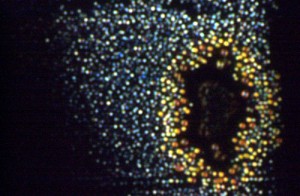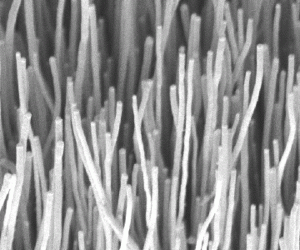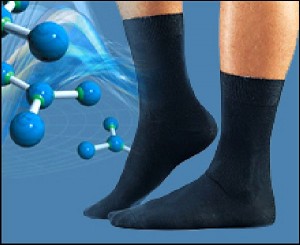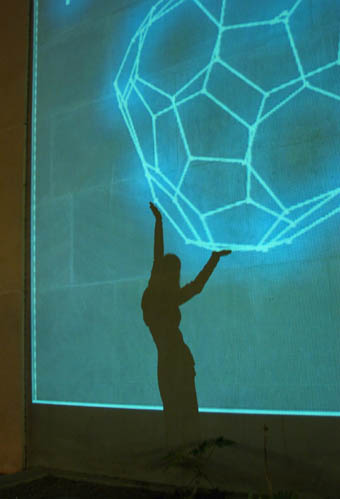 I sat on the wooden floor of a dark and serene room, completely calm and aware of my surroundings. The room was dark except for the neon projection of jelloey structures floating on the wall surface. I used the motion of my shadow to manipulate these floating bubbles using slow, intentional motions, unknowingly slipping further and further into the depths of my own subconscious.
I sat on the wooden floor of a dark and serene room, completely calm and aware of my surroundings. The room was dark except for the neon projection of jelloey structures floating on the wall surface. I used the motion of my shadow to manipulate these floating bubbles using slow, intentional motions, unknowingly slipping further and further into the depths of my own subconscious.
OK, maybe it wasn’t so dramatic. But it was certainly a very calming experience. The jelloey bubbles were in fact images of nano-sized particles called Buckminster balls. The fact that we got the chance to ‘play’ with them using our own shadows let us not only explore the scientific aspect of the behavior of these molecular structures but also see the inspirational quality and the beauty of scientific endeavors.
The beauty of nanoscale particles is projected to fuel many more projects in the arena of entertainment and art. For example, images from scanning microscopes can be used to view the beauty and symmetry of molecules. Further nanoscale particles can be used for other purposes, for instance to create better sports equipment, computers, etc.
So, immediately, various applications for bucky ball projections came to mind. People use such a large variety of methods to rid themselves of depression, stress, and anger: stress balls, yoga, kickboxing, you name it. If this method was to be introduced to the public in an easily attainable manner- it could gain unspeakable popularity. Imagine dance classes where the routine is made up of the motion of the dancer’s shadows and the bucky balls. Imagine yoga classes where the objective is to keep these bucky balls afloat. How about using bucky balls as play things for children, or as replacements for night lights? Even though it may seem farfetched right now, it is possible that we have just come upon a trendy source of entertainment for the 21st century individual.
http://www.ifiwasamillionaire.com/category/nanotechnology/
http://ecow.engr.wisc.edu/cgi-bin/get/interegr/101/zaki/forums/mariannesf/dropboxfor/printedpos/aaronashleyanddonnysegrposter.ppt
http://www.lehigh.edu/~inimagin/intronano.html
http://www.lehigh.edu/~inimagin/intronano.html
http://www.sustainlane.com/reviews/slow-down-how-our-fast-paced-world-is-making-us-sick/HAIOMIOS77WBRNXBRDS3RHHII3HN
Today is complicated for me to describe how intrigued I was by Dr. Rome’s lecture on Nanomedicine. Realizing the possibilities in the near future is something my mind thrives on. Medical procedures, and their futures have always interested me, and have fueled me to work extraordinarily hard in high school, in order to have a successful career as Plastic Surgeon. Thinking about the possibilities of nanotechnology related to my career interest is something I cannot take my mind off. Learning about the Vaults, and how useful they could be to cancer patients and many others, is something anyone with a sane mind would be interested in. I look forward to doing research regarding this topic, during my years in college. Medical science with a technology twist, is the food my mind feeds off of. Researching and learning about present and future treatments is something I am crazy about. Science has always been the class I most look forward to during the school day.
Earlier in the day, I was fascinated about the LUCAS technology developing in the Engineering Department. This complex yet small system, will be ideal for doctors in developing countries who don’t have access to a hospital. Blood testing has never been possible in such portability especially in cell phone format. When I looked at the LUCAS hardware, I couldn’t help but noticed it hooked up through USB. The first thought that entered my biased Apple, and Steve Jobs like mind was iPhone App possibilities! Apple as well as the medical treatment will always continue to advance, become smaller, and last, but not least, become cheaper. Devices like the LUCAS, and iPhone 3G S are living proof of this theory. What I learned today, will stick with me for the rest of my life, and I hope to use the knowledge I learned today, to help me with my passion for science and medical advances.
http://www.cnsi.ucla.edu/institution/personnel?personnel_id=45967
http://www.nseresearch.org/2003/NewFiles/High03_NIRT_UCLA.pdf
http://nsf.gov/discoveries/disc_summ.jsp?cntn_id=104106&org=NSF
http://newsroom.ucla.edu/portal/ucla/cell-phone-prototype-of-lensless-77054.aspx
http://www.youtube.com/watch?v=HTC2k7p8OrI
Posted in Uncategorized | Tagged group y |
Blog for Wednesday third day of the class Group X.
Today it was realized that the lab coats can contain nanoparticles that keep off all stains, and the way that this is possible is because the electrolytes and dyes inside the solutions involved are reflected off the lab coat. This creates an interesting perspective for us to see, we can now imagine clothing that cannot be stained: what if something important such as some expensive article of clothing could keep all stains off: like the ad hominem argument? The world could have all stains not as a big deal, instead they could just be considered such an experience and endeavor that allows nothing important to happen. Silver particles can also be involved in such processes, as they have antibacterial properties that allow clothing to keep bacteria from emitting odourous materials. Anyhow, this does not always work, because the bacteria can keep the silver ions off due to sometimes being hydrophobic. It is so interesting to imagine a substance that stays on your body and keeps off bacteria, however we like bacteria because they are so important for our existential finalities. The ending conclusion is that we can imagine clothing to be in the future, however; how can we do such things when the bacteria involved in the process are subcutaneous? 


The nanoparticles sometimes involve signs, they help to create warning signs for people who want to use nanoparticles in their clothing
http://www.technovelgy.com/ct/Science-Fiction-News.asp?NewsNum=1030
http://news.cnet.com/8301-17938_105-9689466-1.html
http://www.america.gov/st/washfile-english/2004/November/20041123143759lcnirellep0.379986.html
http://www.tms.org/pubs/journals/jom/0507/byko-0507.html
http://www.nanolawreport.com/2008/02/articles/nanoparticle-penetration-of-respirators-clothing-and-gloves/
This first day of visiting labs was filled with excitement. I was intrigued to look at the different equipment that is available at the nano level. When I began this course, I had no idea what a large array of technology was available for these procedures. Science and technology has always been my passion and my career interest. After I complete my first four years of college, I plan to become a physician. Learning about possible futures of medicine was so riveting that I know this course will continue to be fantastic. The rotating lab visits were very interesting to me because it is easier for me to retain information that way. Learning about the one microscope (con-focal microscope) that uses different lasers to image cells at a lower picometer level was extraordinary. I remembered the professor saying that it was the only one in the United States. When I apply to colleges, in the early months of Senior, I will remember that detail when deciding which college I will apply early decision for.
In another lab, I couldn’t help but be perplexed by the electron microscope. Ever since I was a little kid, I have always wanted to see one in person. My goal came true today. Serge made the specifics of the electron microscope interesting and comical. I will always think of his Russian accent, and the way he used imagination, and fascination to enjoy what he does. His passion for what he accomplishes in day to day basis, made me more interested in electron microscope, and I enjoyed reading even more information about them, when I returned to my dorm. Overall, today left me in awe with all the ways science is improving and aiding the world around us.
http://en.wikipedia.org/wiki/Electron_microscope
http://www.unl.edu/CMRAcfem/em.htm
http://en.wikipedia.org/wiki/Confocal_laser_scanning_microscopy
http://www.physics.emory.edu/~weeks/confocal/
http://www.anes.ucla.edu/~estefani/
Posted in Uncategorized | Tagged group y |
Today we learned a lot about nanotechnology and its relation to medicine and nature. We learned about the research that is being conducted to find an alternative to chemotherapy through the use of nanotechnology and nanobots. They would target only the diseased cells and spare the healthy ones, causing the patient a lot less suffering than if macrotechnology (like chemotherapy) was used. If we can find a safe way to detect and cure cancer, it would be a breakthrough in science and the medical field. In addition, the same technology could be used to treat so many other diseases and a new way of detecting disease and bacteria before the symptoms start to manifest itself.
During the day, we also got to visit some labs and professors, one of whom was studying cancer. We looked at cancer cells and discussed the possibilities of using nanotechnology as a safer way of treating diseases.

Nanotechnology used to kill cancer cells
We also learned about the environmental concerns related to nanotechnology. There is often concern that silver nanoparticles released may end up harming the surrounding environment. This may cause damage to the sewer system or ecological systems because the particles may kill off beneficial bacteria. So far, only Berkeley regulates waste on the nano scale, but many researchers and toxicologists are studying the adverse effects of nanotechnology on humans and nature.

Right now, there aren’t that many products on the market that include nanoparticles, such as the socks that kill bacteria through the inclusion of silver particles. However, this idea and research could lead to numerous other beneficial products such as anti-bacterial medicines, self-cleaning clothes, computer chips or anything else.

http://en.wikipedia.org/wiki/Nanotechnology
http://www.edf.org/page.cfm?tagID=77
http://nano.cancer.gov/resource_center/nano_critical.asp
http://ehstoday.com/industrial_hygiene/news/ehs_imp_79677/
http://www.rsc.org/chemistryworld/News/2009/February/25020901.asp
Blog for Tuesday of first week of Nanotechnology course:
I realized that nanoparticles could do some very interesting things. They can reach into the human body and attack foreign cells for help when the human body is not able to do such things. They also have some artistic abilities, which involve the screens where the particles can reside themselves in water, involving the dihydrogen monoxide necessary for such approaches and also the interesting necessities involved. However, I will elaborate on this discussion tomorrow. It is not necessary at such times as this. Anyhow, the nanoparticles can act as T-cells and attack cancerous cells, releasing toxins to activate apoptosis when the cells are not in agreement with the pH of the surroundings. Phenyl red is involved to hold the nanoparticles which activate certain processes within the cells. The nanoparticles can also malfunction, however, and in the human body, what could happen if such a thing proliferated outside of the proliferating pool? It is similar to the differentiating PTHrP signaling required to inhibit precocious chondrocyte hypertrophy by keeping the proliferating chondrocytes in the proliferating pool, because the osteoclasts are growing too slowly sometimes, causing the error of the calcium permeable ion channel allowing too many calcium ions to proliferate.

They are necessarily creating an attack: hurting each cell that is targeted

They are used in the immune system to attack certain species of proliferating dangerous bacteria and viruses with antibodies, and the nanoparticles enable this ability
http://www.azonano.com/news.asp?NewsID=12345
http://www.physorg.com/news106832049.html
http://nano.cancer.gov/news_center/2007/sept/nanotech_news_2007-09-26e.asp
http://www.sciencedaily.com/releases/2009/06/090630132059.htm
http://www.newscientist.com/article/mg17924092.200-magnetic-nanoparticles-to-pinpoint-viruses-in-body-scans.html
In class on Tuesday, we discussed visualization in relation to science. I thought that the topics were interesting because whenever I hear the word “visualization,” I only think of art as in paintings, drawings etc. that were shown at the beginning of the presentation. However, through the lecture I also learned about the visualization in terms of mapping out surfaces and materials within science such as with the atomic force microscope, which measured through the use of a thin probe or tip. We also got to see these microscopes first hand during the lab visits. It was interesting to learn how a concept that is usually associated with art in my mind actually applies to science and research.

Here's an example of the microscope we saw.
We also learned about different types of nanotechnology, such as the “nanobot,” which is like a minature robot. Although advanced nanobots have yet to be created, scientists have primiative molecular machines that can do things such as counting molecules. However, in the future, scientists may engineer nanobots that will be able to kill cancer cells or diagnose diseases. By working together, they can treat a patient on cellular level without all the side effects we have nowadays.
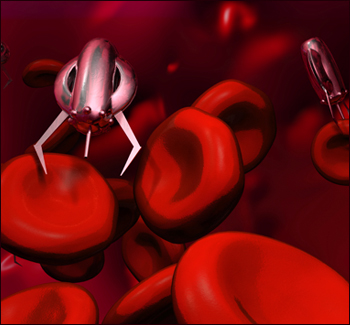
In class, we also viewed a confusing video on the tenth dimension. This was really thought-provoking because it used artistic or mathematical concepts such as lines and points to help the viewers wrap their mind around the concept of ten different dimensions.

http://www.purdue.edu/REM/rs/sem.htm
http://www.understandingnano.com/medicine.html
http://imaginingthetenthdimension.blogspot.com/
http://www.nanobot.info/
http://news.bbc.co.uk/2/hi/science/nature/7288426.stm
When I heard that today’s topic would be “Seeing the Invisible,” I wasn’t so sure what to expect. Immediately, I thought of supernatural phenomena such as X-Ray vision or crazy magic Harry Potter powers. My imagination thought of all sorts of wild, impossible things that could never be done. Instead, we learned about visualization in art and medicine. The use of the camera obscura greatly transformed the world of art, allowing painters to make more realistic pictures than ever before, as seen in the famous “Arnolfini’s Marriage” by Jan Van Eyck. 

Although the camera obscura was an advancement in both art and technology, I believe that process of making the paints by mixing different pigments was an advancement in science as well. By improving the formula of the paints (which of course, is chemistry), they appeared more vibrant, had a smoother texture, and laster longer thus making the portrait seem more realistic as well. In addition to art, the “invisible” was also seen in medicine. The French scientist Louis Pastuer explored the multiplication of bacteria in his “Germ Theory.” This allowed us to see the millions of bacteria and microbes that are constantly growing and developing everywhere around us.
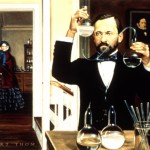
We also discussed X Ray diffraction and Bragg’s Law, which says that X Rays diffract at twice the incident angle. Later, we went to see the different labs and microscopes. My favorite researcher was Sergay, because he had a friendly disposition and a charming accent. I loved looking at the different specimens, it was a million times better than the crappy cheap Wal-Mart microscopes that my school provides.
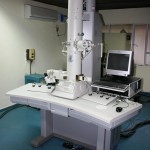
Even though I didn’t learn about any Harry Potter voodoo invisibility seeing magic, I still enjoyed today’s fascinating lecture.
Posted in Uncategorized | Tagged Group Z |
By Lily | Published:
July 8, 2009
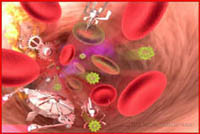 So today we learned how they’re using nano-technology in medicine. One nanometer is equal to one billionth of a meter. Did you know the nose can smell 25 parts per million in the air? We also went into quantum dots again which is clusters of semi-conductors, single oxcitation, and multi-color emission. If its 2nm then the color would be blue where as if it were 7nm it would be red. The color is directly dependent on nm.
So today we learned how they’re using nano-technology in medicine. One nanometer is equal to one billionth of a meter. Did you know the nose can smell 25 parts per million in the air? We also went into quantum dots again which is clusters of semi-conductors, single oxcitation, and multi-color emission. If its 2nm then the color would be blue where as if it were 7nm it would be red. The color is directly dependent on nm.
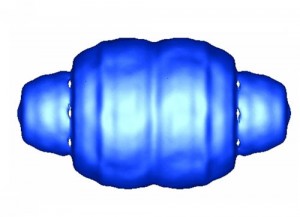 I also learned about vaults today which is made of three proteins; major vault protein, TEP1 VPARP, and RNA. They’re found in our blood cells and have yet to find a reason for them. They’re like hallow capsules and scientists are thinking of possibly being able to put medicine and transport it in them since the body is already familiar with it. They have also been able to create vaults but without the other two components, just the MVP gene. They would put it in the infected piece of DNA, insert that into insect cells, which then makes lots of MVP, and then they just self assemble. The uses for these vaults are therapeutic, biological sensors, and nano.
I also learned about vaults today which is made of three proteins; major vault protein, TEP1 VPARP, and RNA. They’re found in our blood cells and have yet to find a reason for them. They’re like hallow capsules and scientists are thinking of possibly being able to put medicine and transport it in them since the body is already familiar with it. They have also been able to create vaults but without the other two components, just the MVP gene. They would put it in the infected piece of DNA, insert that into insect cells, which then makes lots of MVP, and then they just self assemble. The uses for these vaults are therapeutic, biological sensors, and nano.
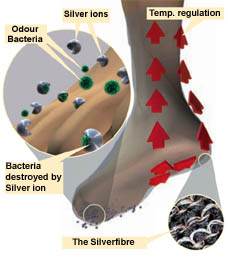 Then we learned bout silver and how its a natural bacterial killer. I thought the video we saw was pretty cute and the experiment the two kids were simple yet showed pretty good results. On the market are silver infused Band-Aids, and socks to stop the odor. The experiment they did found it false to reduce/eliminate odor but it did kill the bacteria.
Then we learned bout silver and how its a natural bacterial killer. I thought the video we saw was pretty cute and the experiment the two kids were simple yet showed pretty good results. On the market are silver infused Band-Aids, and socks to stop the odor. The experiment they did found it false to reduce/eliminate odor but it did kill the bacteria.
The ending i thought was the coolest. They had lab suits that repelled liquids that were spilled on it. I’d seen the business suits they have with that kinda technology but it was the first time in person. That was pretty cool but if the liquid stayed too long in a particular spot it would eventually go through the material.
http://www.foresight.org/Nanomedicine/
http://www.nseresearch.org/2003/NewFiles/Over03_NIRT_UCLA.pdf
http://www.nano-silver.com/
http://www.newmediaexplorer.org/sepp/2006/12/07/nano_silver_kills_microbes_epa_up_in_arms.htm
http://www.nanooze.org/english/articles/nanoquest_fabrics.html
Nanotechnology, the technology of the near future, has both positive and negative aspects. The nanotechnology used beneficially for human health is called nanomedicine. Nanomedicine will use engineered molecular systems and molecular knowledge of the human body to maintain and improve human health. Many scientists and physicians can use this technology as tools for disease diagnosis. They utilize nanofibers as biosensors. The majority of the biosensors are made up of polyaniline. Many products of using this new technology to further understand cell biology and manipulate or repair tissues within the body. A new application within the new technology is the use of quantum dots, q-dots. When excited with a laser, they admit light at a certain wavelength. With these new discoveries came another discovery. The scientists discovered that cells actually act in a group and move in packs: compartmentalized. Another invention, made by Carlo Montemagno, is the biobot. This robot is the tech of the future. During the inventive process, they first used mouse heart cells, which they grew on a metal plate showered with gold nanoparticles that adhere to cells. After these cells grow onto each other, they beat in sync and power the device. With this technology, the future may be the propellor for us to fly from reality to our wildest fantasies. Professor Godwin presented the information on fine silver nanoparticles used in clothing to eliminate bacteria, such as those causing odors. However, these silver nanoparticles are released into the water when washed and could potentially be harmful to the environment. One of Professor Rome’s most prominent discoveries is that of the vault. A vault is made from 3 proteins and a small RNA. These cells are hollow and are recognized and read by the body. The major vault protein, MVP, and two minor proteins, TEP 1 and VPARP, make up the vault. Because of the recognizable nature of vaults, they have the capacity to protect, regulate, and transport. These vaults can be utilized in the future as vectors to transport medicines such as chemotherapy and other anti-cancer drugs.
Links
 I sat on the wooden floor of a dark and serene room, completely calm and aware of my surroundings. The room was dark except for the neon projection of jelloey structures floating on the wall surface. I used the motion of my shadow to manipulate these floating bubbles using slow, intentional motions, unknowingly slipping further and further into the depths of my own subconscious.
I sat on the wooden floor of a dark and serene room, completely calm and aware of my surroundings. The room was dark except for the neon projection of jelloey structures floating on the wall surface. I used the motion of my shadow to manipulate these floating bubbles using slow, intentional motions, unknowingly slipping further and further into the depths of my own subconscious.





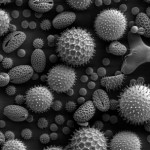
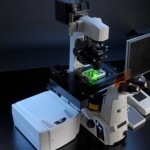
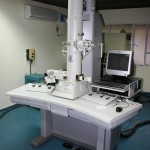













 So today we learned how they’re using nano-technology in medicine. One nanometer is equal to one billionth of a meter. Did you know the nose can smell 25 parts per million in the air? We also went into quantum dots again which is clusters of semi-conductors, single oxcitation, and multi-color emission. If its 2nm then the color would be blue where as if it were 7nm it would be red. The color is directly dependent on nm.
So today we learned how they’re using nano-technology in medicine. One nanometer is equal to one billionth of a meter. Did you know the nose can smell 25 parts per million in the air? We also went into quantum dots again which is clusters of semi-conductors, single oxcitation, and multi-color emission. If its 2nm then the color would be blue where as if it were 7nm it would be red. The color is directly dependent on nm. I also learned about vaults today which is made of three proteins; major vault protein, TEP1 VPARP, and RNA. They’re found in our blood cells and have yet to find a reason for them. They’re like hallow capsules and scientists are thinking of possibly being able to put medicine and transport it in them since the body is already familiar with it. They have also been able to create vaults but without the other two components, just the MVP gene. They would put it in the infected piece of DNA, insert that into insect cells, which then makes lots of MVP, and then they just self assemble. The uses for these vaults are therapeutic, biological sensors, and nano.
I also learned about vaults today which is made of three proteins; major vault protein, TEP1 VPARP, and RNA. They’re found in our blood cells and have yet to find a reason for them. They’re like hallow capsules and scientists are thinking of possibly being able to put medicine and transport it in them since the body is already familiar with it. They have also been able to create vaults but without the other two components, just the MVP gene. They would put it in the infected piece of DNA, insert that into insect cells, which then makes lots of MVP, and then they just self assemble. The uses for these vaults are therapeutic, biological sensors, and nano. Then we learned bout silver and how its a natural bacterial killer. I thought the video we saw was pretty cute and the experiment the two kids were simple yet showed pretty good results. On the market are silver infused Band-Aids, and socks to stop the odor. The experiment they did found it false to reduce/eliminate odor but it did kill the bacteria.
Then we learned bout silver and how its a natural bacterial killer. I thought the video we saw was pretty cute and the experiment the two kids were simple yet showed pretty good results. On the market are silver infused Band-Aids, and socks to stop the odor. The experiment they did found it false to reduce/eliminate odor but it did kill the bacteria.